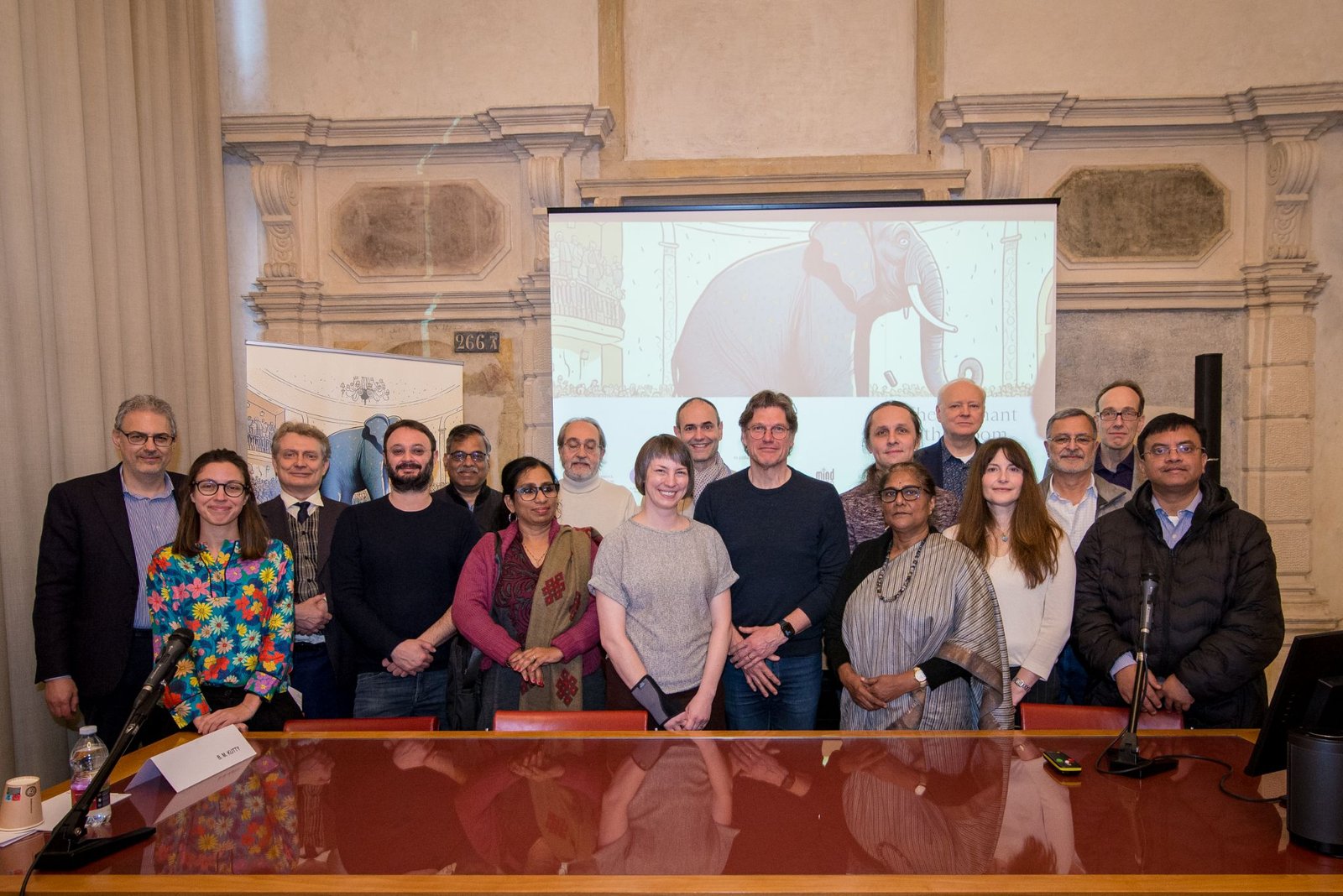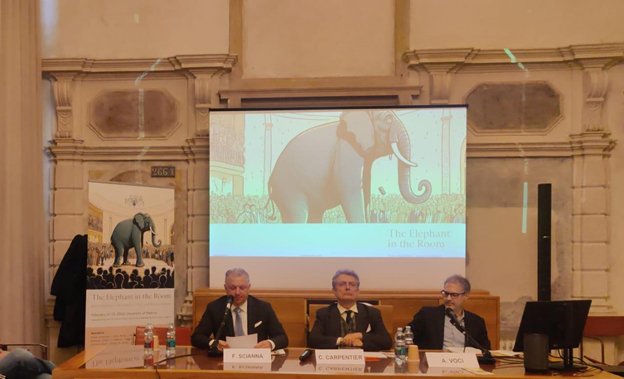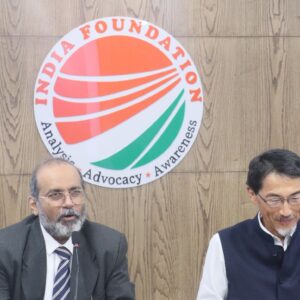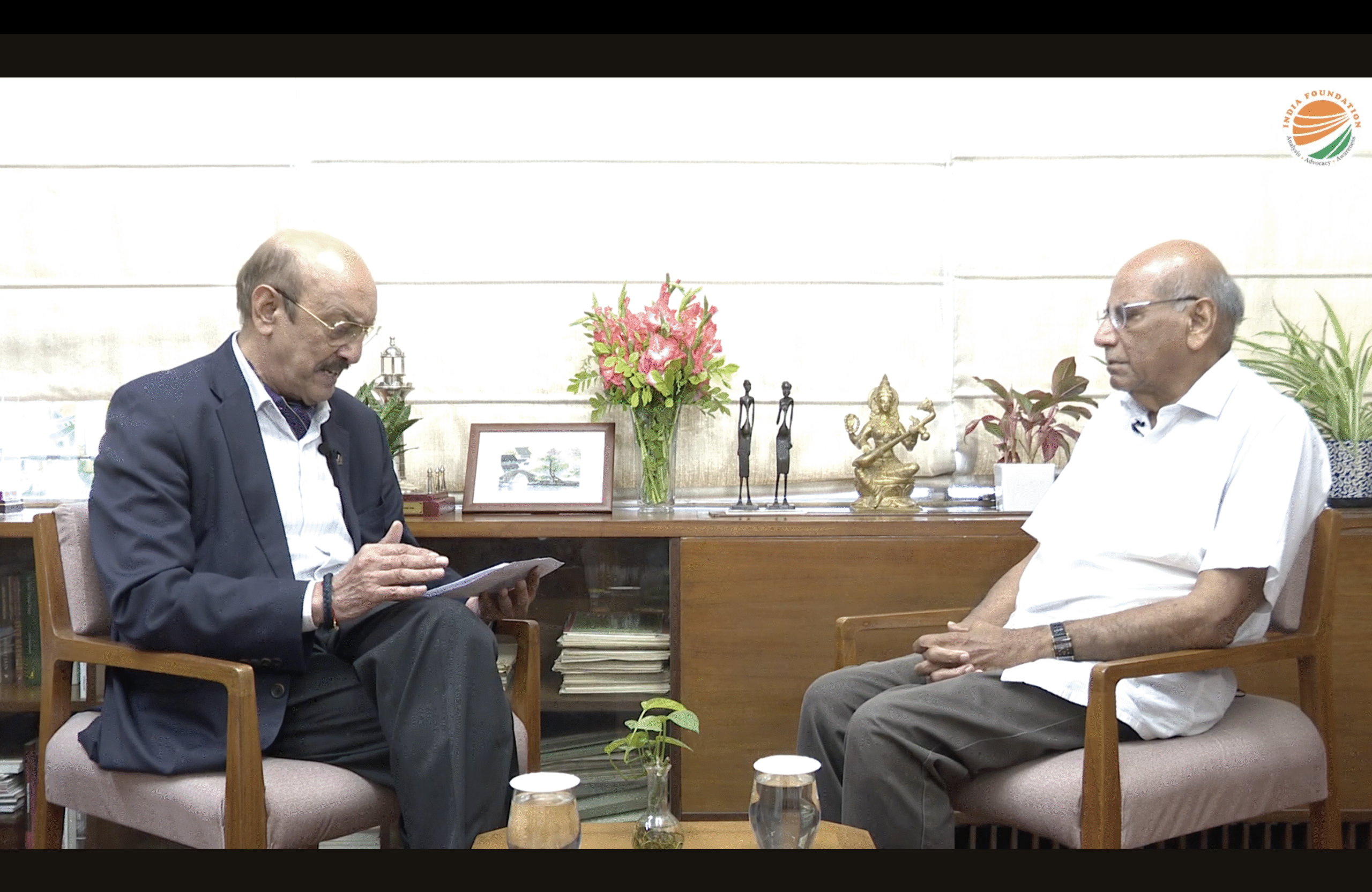Investigating Consciousness Beyond Reductionism
The India Foundation, University of Padova, and the Italian Buddhist Union co-organised an international conference in Padova, Italy themed, “The Elephant in the Room: Investigating Consciousness Beyond Reductionism” on 21-23 February 2024 in collaboration with Mind and Life Europe, the University of Ottawa and the Mind Care Foundation. This conference is the second edition of a series of international events on this theme launched by the India Foundation The conference was addressed by 22 of the leading philosophers, scientists, and scholars across various disciplines, including neurophysiology, physics, psychiatry, and philosophy.
The conference began with opening remarks by Dr. Filippo Scianna, President of the Italian Buddhist Union, Mr. Come Carpentier, Distinguished Fellow, India Foundation and Dr. Alberto Voci, Professor, Department of Philosophy, Sociology, Pedagogy and Applied Psychology – FISPPA, University of Padua. All expressed their satisfaction to participate in the event on a subject of deep scientific, philosophical and cultural importance for the future of humankind. Come Carpentier recalled the contributions to the field of some of the intellectual luminaries who taught or studied at the University of Padova since mediaeval times and he highlighted the need to continue and expand the interactions and collaboration between India and the West in the domain of consciousness research, given the seminal contribution that Indian native knowledge systems have made in this area during thousands of years.
Day 1
Session 1: Insights from Contemplative Traditions
The first session was divided into two panels; the first panel was chaired by Marcello Ghilardi, Professor and Researcher in Aesthetics, University of Padua, and featured two speakers, Paavo Pylkkänen, Senior Lecturer in Theoretical Philosophy, School of Bioscience, University of Skövde in Finland and Sangeetha Menon, Professor & Head, NIAS Consciousness Studies Programme, Indian Institute of Science, Bangalore.
Paavo Pylkkänen began his address with a brief introduction to the reductionist, non-reductionist, and non-illusionist approaches. He discussed the shortcomings of each approach and spoke of Bohm’s wave theory which indicates that pilot waves guide the particles, inferring the possibility of consciousness guiding the mind. He said, “Information exists all around us but is not meant for us. It’s meant for cells and particles, and it makes things happen even without our awareness”.
Sangeetha Menon narrated briefly the story of Nachiketa from Katha Upanishad explaining the Indic understanding of atma. She spoke of the philosophy behind consciousness and touched upon the implications of Artificial Intelligence in consciousness studies.
The second panel of the session was chaired by Ilaria Malaguti, Associate Professor, Department of Philosophy, Sociology, Pedagogy, and Applied Psychology – FISPPA, University of Padua, and consisted of two speakers, Bruno Neri, Professor, University of Pisa and Bindu M. Kutty, Professor, Dept. of Neurophysiology, NIMHANS, Incharge Professor and Coordinator of NIMHANS Center for Consciousness Studies in Bangalore, India.
Bruno Neri briefly summarised the advantages and drawbacks of the reductionist approach to consciousness. He put forward the key question, “Can consciousness be reduced to its neural correlates considering its fundamental nature ?” He derived from his study in a Tibetan monastery in India where he recorded the brain activity of monks during meditation. He provided a neurophenomenological description of brain activity levels across various stages of consciousness during the meditation practices.
Bindu Kutty discussed her study which involved the use of EEG on meditation practitioners during the meditation process and the variations observed based on the techniques of meditation used. According to the study, there was a global enhancement of spectral power indicating entrance into a different state of consciousness in monks which is distinct from the sleep state. She also found direct effects of meditation on cognitive function and flexibility as well as stability of mind.
Session 2: Beyond Duality
The second session was chaired by Silvia Capodivacca, Researcher in modern and contemporary philosophy of the French and German schools (Nietzsche, Deleuze) at Padova, and included two speakers, Catherine Prueitt, Assistant Professor, University of British Columbia, Canada, and Zoran Josipovic, Adjunct Assistant Professor, Department of Psychology, New York University.
Catherine Prueitt spoke from the perspective of the Indian (Pratibhijna) cosmopsychism of Utpaladeva and Dharmakirti clarifying that her approach can be described as a form of priority monism where consciousness is the fundamental individual that defines reality. In other words, she spoke of the Unitary Shiva or the one universal reality. She notes that Shiva tattva is, “consciousness as the infinite variegation able to express itself as any and all manifest worlds” and therefore noted that, according to this approach, space and time are powers of the universal consciousness i.e. they arise out of the processes of universal consciousness.
Zoran Josipovic spoke about the pure awareness and the explicit nature of non-duality stating that consciousness is homogenous and a phenomenon/entity of non-dual reflexivity. He noted, “Inherent non-conceptual reflexivity is unique to consciousness itself, It makes it what it is”
Session 3: Contributions from Physics and Mathematics
The third session was chaired by Marcello Ghilardi, Associate Professor in the Department of Philosophy, Sociology, Education and Applied Psychology at the University of Padova, and had three speakers, Chetan Prakash, Affiliate Member, Association for Mathematical Consciousness Studies, Emeritus Professor of Mathematics, California State University and Senior Lecturer in Aikido, Donal D. Hoffman, Professor of Cognitive Sciences, University of California, Irvine and Federico Faggin, Physicist, Engineer, Inventor and Entrepreneur based in the USA.
Chetan Prakash briefly outlined the history of physics from 19th Century classical physics to 20th century Quantum Theory leading up to a modern realisation, and to a new approach based on the understanding that spacetime has no operational use below Planck’s length (a scale of 10-33 cm and time intervals of 10-43 seconds). Increasing quantum measurement accuracy multiplies the degrees of freedom limited by the blackhole formation. This understanding has led to the formulation of several positive geometries and other mathematical entities. With this background, the Consciousness Realism Hypothesis was introduced, (The world of an agent is a network of consciousness agents) and the experiential dynamics of a single agent was defined by the following formula:
Q (Qualia) = DAP (Decisions Actions Perception)
Donal D. Hoffman further explained the work he and Chetan Prakash were collaborating on, explaining how even within the framework of evolutionary theory, vertical selections go extinct. Elaborating on the limitations of space-time and reductionism as well as on the imminent end of the usability of those approaches as physics and science move forward, he went a step further to say that quantum theory is not fundamental. The team now proposes to use Markov Kernels to study Qualia.
Federico Faggin emphasised that consciousness can’t be explained via anything that isn’t as simple as itself. He said, “ Consciousness is a quantum property of nature” and “space and time are derivative and emergent properties of consciousness”
Day 2
Session 1 Philosophical and Epistemological Inquiries
The first session of the second day of the conference had two panels. The first panel was chaired by Chiara Mascarello, Associate Professor, Department of Asian and Mediterranean African Studies of the University of Padova and listed three speakers, Kathinka Evers Professor of Philosophy and Senior Researcher, Centre for Research Ethics & Bioethics (CRB), Uppsala University in Sweden; Juan Arnau, Philosopher and Writer, professor at the Complutense University of Madrid, Spain, as well as Riccardo Manzotti, Professor, Department of Business, Law, Economy and Consumer Affairs and Faculty of Communication, IULM University, Italy.
Kathinka Evers commented on the Western perspective towards consciousness. She explained that psychological dissociation has 3 forms, dissociation with nature, with the other, and with the conscious self. In the West consciousness has historically been linked to souls which were held to be exclusive to humans. Among humans too hierarchies were assumed; for instance there were debates as to whether women had souls and Darwin himself classified women between children and men. There was also a hierarchy of races: white men had souls while ‘primitives’ from other continents might not have them to the same degree, according to some racist thinkers. The mindset dictated the bias of Western science which supported it with allegedly factual experimental data, making it easier to justify genocide. From this extreme, the West has now swung to the opposite notion, i.e. panpsychism where even elementary particles are hypothesised to have some form of consciousness. Throughout her talk, Dr Evers highlighted the biases and flaws that ‘Western’ science is susceptible to and should be careful of. She also spoke about the risk of humans creating artificial intelligence with the intent of eventually creating conscious machines. Though she believes that this is not possible anytime soon, she wondered whether people have truly thought about the implications of such a development.
Juan Arnau highlighted the understanding of consciousness from three viewpoints, Mahayana Buddhism, Samkhya Philosophy, and the Philosophy of Science. He broke down the difference between consciousness and mind within the Buddhist teaching where mind and matter are categorised together and separate from consciousness. He also explained the Samkhya perspective which states that intelligence, the self and the mind arise from the interaction between pure consciousness (Purusha) and mind-matter (Prakriti). He commented on the ability of science to know reality stating, “Science doesn’t open the pot to see the stew, it cooks the stew”
Riccardo Manzotti brought a different perspective and approach. He proposed a reductionist physicalist view where the object dictates the mind. He noted that the experience does not have material counterparts, therefore, these can’t be accepted as reality. He spoke of the Causal Self-Referential Theory of Perception, i.e. perceptual content is satisfied by an object only if the object in question has caused the perceptual experience. Anticipating a question on dreams and hallucinations he said, “Dreams are extensions of the existent present, based on past events registered”.
The second panel of the session was chaired by, Andrea Gambarotto, Maria Zambrano Fellow, Department of Philosophy, Centre for Research on Life, Mind and Society, Department of Philosophy, University of the Basque Country (Spain) and consisted of two speakers, Sebastjan Vörös, Associate Professor at the Department of Philosophy, University of Ljubljana, Slovenia and Philip Goff, philosophy professor, Durham University, UK
Sebastjan Vörös explored the potential of Francesco Varela’s concept of Dynamic Systems Theory as a way of understanding consciousness. He elaborated on the crucial aspect of autonomous systems i.e. the circularity of their function and underlined the fact that the living being is situated in the environment. He said, “An organism, by enacting itself, enacts its own meaning”. In other words, a living being brings meaning to the external world in its own context, creating its autonomous identity.
Philip Ghoff gave a virtual address on free will and the evolution of consciousness. He highlighted the mystery of Psycho-Physical Harmony. He explained his version of panpsychism where consciousness is not confined to biological entities but is a fundamental feature of all physical matter. He explained how our current scientific paradigm was designed by Galileo to exclude consciousness. He separated the physical world from its qualities so that we could exhaustively describe it in purely quantitative mathematics. Galileo appreciated that we can’t capture the qualities we find in our experience in that manner. Therefore, he proposed a radical new theory of reality, according to which the qualities aren’t part of the physical world, that is the domain of science. Rather, they are in the consciousness of the observer. If we now want a science of consciousness, we need to find a way of bringing consciousness back into the domain of science. We need to find a way of bringing back together these two domains that Galileo separated. Panpsychism is one way to go about this. We can’t get consciousness out of physics, but you can get physics out of consciousness.
Session 2: Neuroscientific Hypothesis on Consciousness
The second session of the day had two panels. The first panel was chaired by Nicola de Pisapia, Associate Professor, Department of Psychology and Cognitive Sciences, University of Padova, and included 2 speakers, Georg Northoff, Philosopher, Neuroscientist and Psychiatrist, University of Ottawa in Canada, and Giuseppe Pagnoni, Associate Professor, Department of Biomedical, Metabolic and Neurosciences, University of Modena and Reggio Emilia, Italy.
Georg Northoff presented his approach towards understanding consciousness, based on a complex multiscale temporal organisation displayed in the brain governed by different timescales. He explained this with an analogy. Imagine a wall with different size windows beyond which you can see a house, depending on which window you look through, you will see a different part of the house with different proportions. Maybe one window gives the view of the entire house, the other might give a view of just part of its roof. This input of information defines our perception. Time scales play the role of similar input points for the way information enters our mind and all these time scales together project information onto our consciousness. Therefore, while not part of the consciousness itself, these time scales act as the key to understanding consciousness or to oversimplify it, acting as a bridge between internal consciousness and external reality.
Giuseppe Pagnoni spoke on the potential role of the free-energy principle in our understanding of meta-awareness, self, and consciousness. Introducing the hierarchical generative model he explained how the mind potentially interacts with the world across various levels of temporal depth. He described the possibility that all our cognitive activity is made up of inferences from our beliefs that are updated every time we interact with the world. These beliefs are expectations of what we are about to encounter. He also spoke about meditation and the case of mind wandering, referring to the difference between intentionally focused thought and an uninterrupted flow of thoughts.
The second panel was chaired by Francesco Tormen, Associate Professor, Department of Asian and Mediterranean African Studies, University of Padua, and had two speakers, Steven Laureys, Neurologist, Neuroscientist, clinical professor of neurology at the Liege University Hospital and Research Director at the Belgian National Fund for Scientific Research, and Christof Koch, Meritorious Investigator, Allen Institute, USA.
Steven Laureys spoke on the Neurology of Consciousness. From Coma and near-death experiences to Meditation and Hypnosis. Revealing his team’s observations and findings while studying all these processes. His team’s research broke down consciousness into its content (awareness) and levels (wakefulness) to measure it for their study, where a coma is the state of lowest awareness and wakefulness, followed in ascending order by general anesthesia, stages III-IV of sleep state (along with REM sleep and Lucid dreaming), stages I-II of sleep, drowsiness and finally conscious wakefulness. He broke down the reported experiences of people who faced near-death experiences by distinguishing them from hypnosis, sleep, and meditation on both the experiential level and according to findings from brain mapping techniques used in his study.
Christof Koch presented the fundamentals behind the Integrated Information Theory concerning Consciousness in Nature. He noted that consciousness must be the starting point of any investigation of existence. Here consciousness is not a process, message, neuronal activity pattern, computation or algorithm. He said, “Consciousness is about being while intelligence is about doing”. Keeping this in mind, he further stated that the seat of consciousness is in the posterior regions of the cortex, since the loss of sense (as in a state of pure presence) corresponds to a nadir in neural activity in those regions. He also pointed out that current artificial intelligence systems can never become conscious due to limitations of hardware and programming. These systems merely perform simulations of a certain kind of consciousness phenomenon and simulations cannot become real.
Day 3
Session 1: Further Insights from Neuroscience
The final session took place on the third day of the conference. The chair of this session was occupied by Federico Zilio, Research Fellow, FISPPA Department, University of Padova and this session consisted of a panel of three speakers, Ravindra P. Nagendra, Additional Professor, Centre for Consciousness Studies, Dept. of Neurophysiology, NIMHANS, India; Narayanan Srinivasan, Professor at the Department of Cognitive Science, Indian Institute of Technology Kanpur and Elena Antonova, Senior Lecturer, Division of Psychology, College of Health and Life Sciences, Brunel University, London, UK.
Ravindra P. Nagendra introduced the unique approach to scientific research applied in NIMHANS where the concepts and ideas are derived from both neuroscience and Indian philosophical insights. These ideas are tested using Neurophysiological as well as Cognitive Neuroscientific techniques. The samples studied are categorised based on a wellness-normal-illness scale and states are divided into Rest, Sleep, task-performing, and meditation. He spoke of their study on wave patterns during sleep cycles amongst experienced and novice meditators, along with a control group of non-meditators. That study showed that practitioners of Vipassana meditation exhibit enhanced slow-wave sleep and REM sleep states across different age groups. Among other points, he emphasised the importance of understanding that the sleep state is a continuity of the self and not a loss of consciousness. Being a state of experience, sleep does not amount to a break in awareness or consciousness.
Srinivasan Narayanan spoke about temporal consciousness. He introduced his work about a nested hierarchical model of multiple timescales that accounts for findings on the timing of cognition and the phenomenology of temporal experience. In doing so a framework that hierarchically combines the three major philosophical positions on time-consciousness (i.e. cinematic, extensional, and retentional) is being developed that can display a common basis for temporal experience. At the first level, there is a fast-updating cinematic level that updates its contents every 30–50 milliseconds, with a slight delay in reference to the outside world. Next is the intermediate level, based on the extensional model, unfolding both in and over time every 300–500 ms. This level is also tied to our phenomenological experience. Finally, at the top, the slow-updating level spans a breadth of 3–5 seconds. This level is modelled after the retentional models in time-consciousness. Concept and belief representations are situated at this level that retains and extends onto the intermediate level. The study is based on two assumptions: one, there are aspects of our conscious experience, which are both in and over time, i.e. not only can we experience time but our experiences themselves dynamically evolve, and two, there is an abstract structure of time, a lawlike dynamic evolution over which our experiences unfold.
Elena Antonova discussed the importance of staying with the question. She spoke about radical neurophenomenology as the framework for the neuroscience of consciousness. She noted that rigorous science does not necessitate the application of the scientific method within any kind of metaphysical ontology; if we need an ontology of some kind it would be a phenomenological ontology (what is the nature of being). This way we gain the ability to ask new questions without dismissing anything based on prejudiced beliefs about what is ‘real’. She concluded by saying, “The fear of the unknown should be replaced by the wonder of discovering more of ourselves”.
There was a round of discussions at the end of each session across all three days of the conference.
The conference concluded with closing remarks by Professor Marcello Ghilardi, Anmol Mahajan, Research Fellow, India Foundation and Francesco Tormen, Associate Professor at the University of Padua





